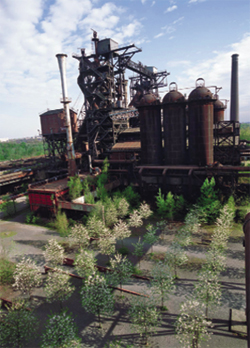My husband Peter and I were married in the Green Gulch meditation hall on April 18, 1976, exactly seventy years after the great San Francisco earthquake. We treasure our April 18th anniversary—it always reminds us not to get too settled down or routinized in married life. Every year we do something special on our day, just the two of us. No zazen, no kids, and absolutely no work allowed in our various overpampered gardens. This year we went for a long romantic walk across an abandoned landfill dump.

We love this rough, inhospitable place where tons of twisted rebar, broken PVC pipe, warped plywood, and cracked blocks of industrial concrete have been dumped for years off the eastern shore of the San Francisco Bay. Although the landfill has been closed since the mid-1980s, it is now a source of wild fertility growing up out of industrial detritus. Rank stands of Jupiter’s Beard valerian mingle with carpets of coastal sage topped by eight-foot-high licorice-scented fennel. This feral landscape pleases me more than all the manicured, well-watered installations of paradise found in modern parks.
I have a young friend named Brook, a newly minted Bay Area landscape architect. She reminds me that the typical site for a large urban park these days is not pristine land but often a deserted landfill like our anniversary dump, polluted brownfields, or even a bombed-out war zone like that in central Beirut, where a new Garden of Forgiveness is being designed out of the rubble of war.
As part of her training, Brook and a team of her colleagues studied a range of postindustrial landscape parks being designed throughout Europe. The 865-square-mile Ruhr District in central Germany generated massive land, air, and water pollution for almost a century of extensive coal mining, electrical power industry, steel mill operations, and chemical manufacturing. Now this industrial wasteland is being redesigned by a collaborative team of landscape architects, municipal governments, and private companies under the provocative name of Emscher River Landscape Park, after the polluted, foul-smelling wastewater ditch that carried the hazardous effluvia of this region throughout the twentieth century.
Of particular interest to me was Duisburg-Nord Landschaftspark, located on the 570-acre grounds of the former Thyssen Steelworks. The landscape contract for this park was awarded to Peter and Anna-Liese Latz for their determination not to hide the brooding menace of this postindustrial place. They considered any changes that covered over or obscured its history to be aesthetic and moral violations. Instead, with very few additions, the Latz team incorporated the threatening structures of the former steelworks into their design.
The genius of Duisburg-Nord resides in its huge blast furnaces and abandoned engine houses that stand exposed, their mythic ruins dominating the abandoned site. Uncovering the industrial memory of the place was accomplished by direct interaction with the true landscape of the park. Here the design of the Latz team is subtractive: all obstacles that obscured the original steelwork structures were removed, and the entire park is put on view from all angles. The foreboding industrial ruins are now connected by modern pathways and aerial bridges. A field of dark purple salvia is planted at the base of a huge coal chimney stack to accentuate its ruined tower. The massive gasometer tank of the old steelworks—scrubbed and filled with fresh water—now serves as a modern scuba diving tank. Mountaineers and adventurous children practice rappelling on the crumbing ore bunker walls that rise up like a giant fortress from the floor of the Ruhr Valley, while throughout the site native and introduced plants colonize and remediate immense toxic slag heaps.
At Duisburg-Nord as well as on our anniversary dump, new parks are evolving out of a wasteland of visible decay. Abandoned places like these are being called “apocalypse landscapes,” from the old Greek meaning of apocalypse, “uncovering, revelation.” “Landscape is culture,” insists Latz, adding in true Zen fashion that landscape as a real object does not exist. This being so, engagement with rusted blast furnaces or slabs of landfill concrete uncovers a whole new world of broken-open beauty, never seen before.
Thank you for subscribing to Tricycle! As a nonprofit, we depend on readers like you to keep Buddhist teachings and practices widely available.